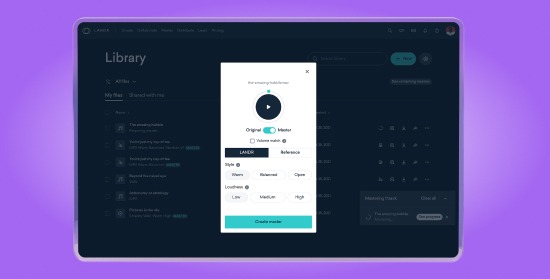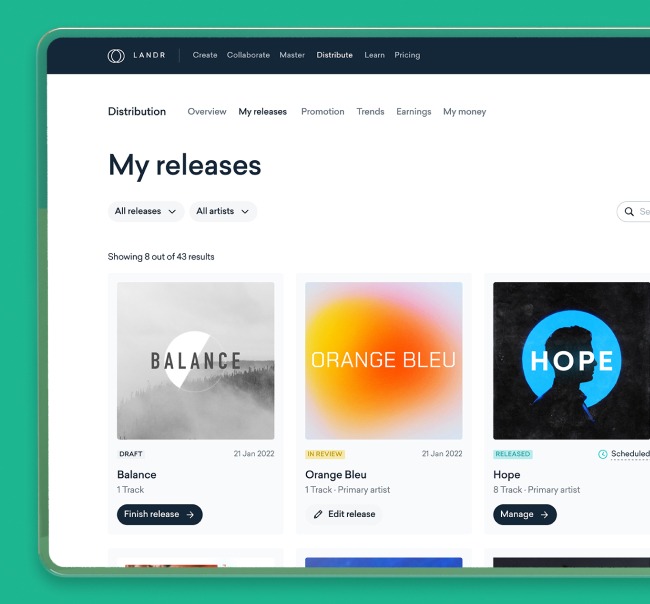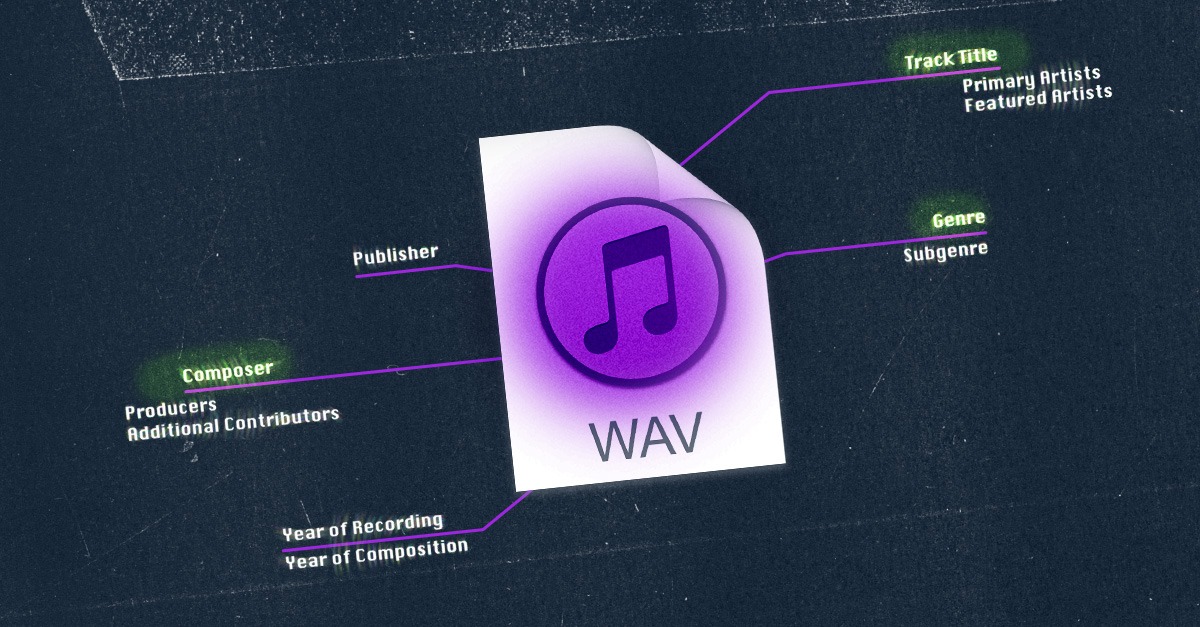
Audio File Formats: Difference Between AIFF, WAV, MP3, Ogg and FLAC

Digital audio files are the raw material of music production.
From streaming platforms to sample packs, all the audio you work with has to be stored somewhere in a file.
But there are many types of audio format that are used in different situations.
How do you know which audio file type to use and how to get the best results?
In this article I’ll explain everything you need to know about audio file formats and how to choose the right one for the job.
Let’s get started.
What are audio file formats?
Audio file formats are digital standards for storing audio information.
The raw data in a stream of audio from the analog-to-digital converter in your audio interface is encoded using a technique called PCM or pulse code modulation.
PCM audio needs to be organized into a file so you can work with it, or play it back in a system.
Different audio file formats use different containers and varying methods of data compression to organize the PCM stream.
Depending on which you choose, each format represents the same information in different storage sizes or quality levels.
In addition to that, some audio file formats carry metadata that supplies information about the file or its content.
What is the best audio file format for audiophiles?
For audiophiles who prioritize audio quality above all else, the best audio file format is typically a lossless format, such as FLAC (Free Lossless Audio Codec) or ALAC (Apple Lossless Audio Codec).
These formats provide the highest fidelity as they preserve the original audio data without any loss, ensuring a bit-for-bit replication of the source material.
FLAC is widely acclaimed for its universal compatibility and open-source nature, making it a popular choice among audiophiles, regardless of the platform.
ALAC, while similar in quality, is particularly suited for users integrated into Apple’s streaming service.
Both these formats offer the pristine audio quality that audiophiles seek, making them the preferred choice for listening to music in its most unadulterated form.
Lossless vs. lossy audio files
There are two main types of audio file—lossless file formats, and lossy file formats.
There are two main types of audio file—lossless file formats, and lossy file formats.
The difference between the two has to do with data compression.
Data compression means making the files take up less space on a hard drive. It’s not the same as the dynamic range compression used in music production.
Some methods of data compression make the file smaller but still preserve 100% of the information in the raw audio stream. These are known as lossless compressed formats.
Other compression types work by eliminating data in the audio that doesn’t make a big impact on the sound. Some information is thrown away using this method, so these are known as lossy compressed formats.
Uncompressed audio formats
There are other audio file formats where no data compression is used. These are called uncompressed audio formats.
These file types act as a container for raw audio data without reducing its size or quality in any way.
These are the largest files to work with, but they provide the highest level of detail in the audio information.
Uncompressed audio files are the type most often used for recording and mixing music in a DAW.
Even so, uncompressed audio files also come in different quality levels. These are based on the accuracy and precision with which the analog audio signal was converted to digital.
The higher the sample rate and bit depth used, the more information is captured in the conversion process.
Bit depth represents the precision of the AD/DA converter for measuring amplitude, or the volume level of the signal.
You can think of it like the number of tickmarks on a ruler—the more closely spaced they are, the less often the measurement will fall in between the two marks.
Sample rate means the number of times the measurement is taken in a second. Higher sample rate means more individual measurements made.
Uncompressed audio files are the type most often used for recording and mixing music in a DAW.
Here is a list of common quality levels for uncompressed audio:
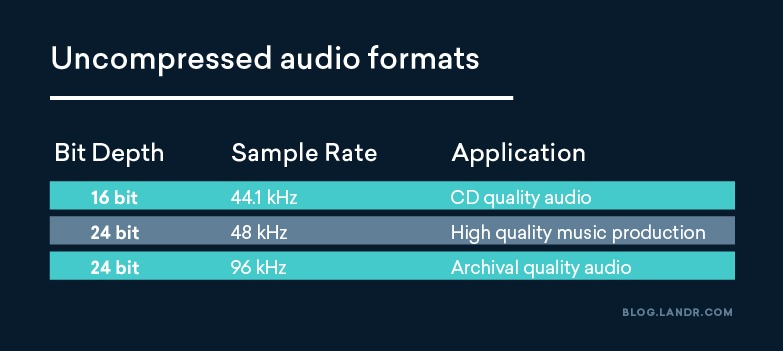
Audio bitrate
Lossy compressed audio files can be encoded at different quality levels.
The quality of this file format is determined by the bitrate, or the amount of data encoded per second.
At lower bitrate settings, the compressed files will be much smaller, but may sound worse.
In the past, this was necessary since storage media had limited capacity and networks couldn’t easily transmit large files.
But storage and bandwidth aren’t so much of a concern in today’s digital world.
That’s why a larger file with higher bitrate is almost always the best choice when you need to use a lossy format.
A high quality standard for MP3 compression is 320 kbps. At these settings it’s very difficult to distinguish compressed audio from uncompressed in casual listening tests.
High-resolution audio
Today’s audio file formats go far beyond the CD-era standard of 16 bit 44.1 kHz files.
With increases in storage and transmission capacity, it’s possible to stream and store files that would never have been practical on physical media.
These options allow you to listen to files with sample raters rates of up to 192 kHz.
Naturally, uncompressed files at that resolution are enormous compared to mp3s.
That’s why engineers developed lossless compression algorithms like FLAC and ALAC to maintain bit-for-bit quality for smaller files.
But there are other unique approaches to high resolution audio. For example, DSD audio uses a single bit word length but a sampling rate many times higher than that of CD.
This results in a high resolution audio experience with unique qualities favored by some audiophiles.
While high resolution audio may seem superior in principle, it’s not always clear that listeners can tell the difference in blind listening tests.
Even so, you may prefer it yourself—especially if you listen on a hi-fi stereo or studio monitor setup.
Streaming platform audio
Speaking of streaming audio, not all platforms are equal in their choice of audio formats.
Streaming audio itself is transmitted over the internet in a compressed form to save on data costs for the user.
Depending on your provider, you can adjust the streaming quality in the settings tab of your app to access higher quality audio files.
There’s no downside to increasing this setting when connected to wi-fi, and some platforms allow dynamic audio
With the exception of some hi-res streaming platforms you’ll like be limited to the equivalent of a high quality mp3
The 5 most common audio file formats
There are many different file formats out there, but not all of them are widely used.
In fact, there are only a handful that you’ll commonly see in the wild. Here are the main ones to know:
1. MP3/M4A
MP3s are the most common file type for general listening.
The use of MP3s exploded during the file sharing revolution of the early 2000s. The reason why has to do with the sound quality they were able to achieve in such a small package.
MP3s were the first audio file format that made music easy to send back and forth across the internet in listenable audio quality.
They were also easy to encode from tracks on a CD, which led to the proliferation of illegal music downloads.
MP3 files are still very common today and some digital download stores like Bandcamp sell them as their primary format.
2. AAC
AAC is a lossy compressed format designed by a group of digital technology companies including Dolby, Microsoft and Bell . It was intended as a more efficient successor to MP3. AAC is known for being the standard format for Apple devices like the iPod.
If you ever bought music on the iTunes store, or used iTunes to rip CDs to your library, you might have some AAC files lying around.
3. Ogg Vorbis
Ogg Vorbis is an open source alternative to lossy compressed formats like MP3. It’s notable for being the file type used for audio material on Wikipedia.
Despite its widespread use, MP3 is a proprietary format. In response, the open source community created Ogg Vorbis as an alternative that’s free and editable.
4. FLAC
FLAC is an open source lossless compressed file format. It was one of the first lossless compressed formats to gain popularity.
FLAC files make listening to lossless audio possible on devices with limited storage. The benefits of lossless audio as a listening medium are often debated by audiophiles, but see for yourself if you prefer them!
5. ALAC
The Apple Lossless Audio Codec (ALAC), developed by Apple, is a pivotal format in lossless audio compression.
It enables perfect audio reproduction, ensuring a bit-for-bit replica of the original audio while maintaining smaller file sizes compared to uncompressed formats like WAV or AIFF. Integrated seamlessly with Apple’s ecosystem, ALAC is not only preferred by Apple users but also supported by various high-fidelity players and streaming services, enhancing its versatility.
With the increasing demand for high-quality audio and the adoption of lossless streaming by services like Apple Music, ALAC’s significance in delivering high-fidelity audio in an efficient format is poised to grow, making it a reliable choice for both music enthusiasts and professionals.
6. WAV/AIFF
These are the most commonly used file types for working with lossless uncompressed audio.
Since there is no change to the amount of information included, both file types have similar performance.
WAV was created for use on PC, while AIFF was developed by Apple for the Mackintosh. Both formats are compatible on either platform.
For music production, use uncompressed audio with high sample rate and bit depth (24 bit / 48 kHz WAV or AIFF)
How to choose an audio file format
With the background info out of the way, here are the simple guidelines for choosing an audio file format:
- For music production, use uncompressed audio with high sample rate and bit depth (24 bit / 48 kHz WAV or AIFF)
- For general listening, choose a high bitrate compressed format (320 kbps MP3, AAC or similar)
- For critical listening, choose a lossless compressed format (FLAC)
How audio file formats are changing
As the landscape of music production and consumption continues to evolve, so do the audio file formats and technologies that underpin these processes.
In recent years, we’ve witnessed a shift towards more immersive and high-quality audio experiences.
This shift is not just about higher bitrates or more efficient compression techniques; it’s about redefining the way we experience audio. Here are some key trends and future developments in this domain.
Spatial Audio and Immersive Formats
One of the most significant developments in audio technology is the rise of spatial audio formats, such as Dolby Atmos and Sony 360 Reality Audio.
Unlike traditional stereo audio, which limits the sound field to a left and right channel, spatial audio creates a 3D soundstage, allowing listeners to perceive sound coming from all directions, including above and below.
Dolby Atmos
Initially developed for cinemas, Dolby Atmos is now making its way into music production.
It allows sound engineers to place audio in a 3D space, adding a new dimension to the listening experience.
This format is particularly effective in creating immersive experiences for movie soundtracks, live performances, and even studio albums.
Sony 360 Reality Audio
Using object-based spatial audio technology, this format enables artists and creators to map sound sources such as vocals, chorus, and instruments with positional information, creating a spherical soundstage.
Virtual reality developers are using these kinds of advancements in audio file formats to create 3D soundscapes.
High-resolution audio for streaming platforms
With the increase in internet speeds and advancements in compression algorithms, high-resolution audio streaming is becoming more feasible and popular.
High-resolution audio files offer greater detail and a higher level of fidelity than standard CD-quality audio.
Services like Apple Music, TIDAL and Amazon Music HD offer high-resolution streaming, providing listeners with quality that surpasses the typical 16-bit/44.1 kHz CD standard.
We’re seeing a trend where more streaming services are considering the adoption of high-resolution audio to cater to audiophiles and discerning listeners.
LANDR Mastering file formats
LANDR Mastering offers downloads in four different quality tiers—LO-MP3, Hi-MP3, WAV and HD WAV.
Here’s a breakdown of each one:
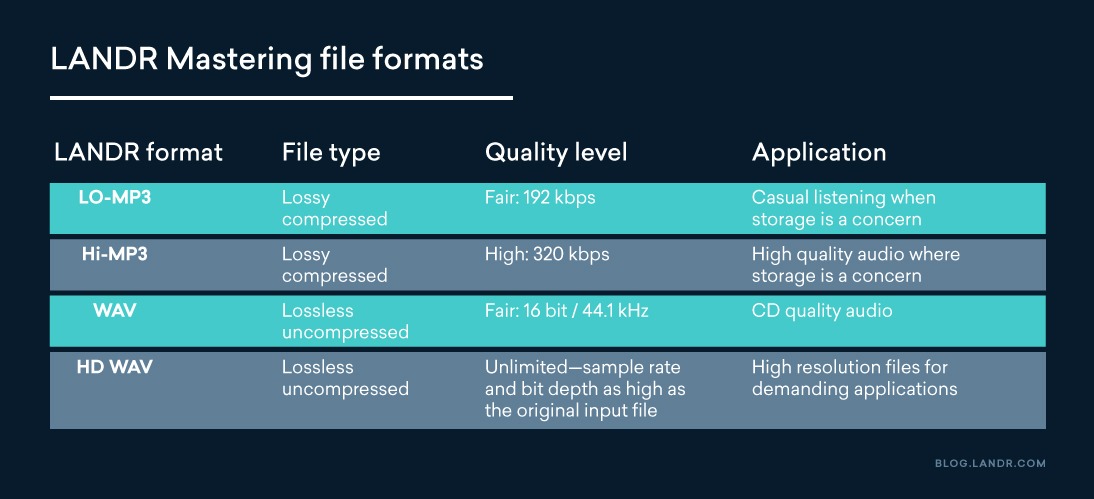
Hot tip: No process in music production can add audio quality back if it didn’t exist already. To get the highest quality file from LANDR Mastering, you need to start with a high resolution file. We recommend setting your DAW sessions to at least 24 bit / 44.1 kHz, or higher if possible.
Metadata in audio files
Metadata is additional information contained in an audio file that isn’t part of its sound content.
It includes important details like the artist name, song title, album, runtime and genre.
Metadata is the crucial information that links a piece of music back to its creator so that credit can be given for its usage.
That means it plays a key role in distribution and rights management.
Metadata for commercially distributed files is normally handled by the distributor, but it’s also possible to embed it directly into the file with online tools.
Check out our guide to music metadata to learn more.
File system
Audio file formats are a technical detail in digital audio that may not seem important.
But choosing the right one can make a difference to your final product.
If you’ve made it through this article you’ll have a great starting for understanding audio file formats.
Gear guides, tips, tutorials, inspiration and more—delivered weekly.
Keep up with the LANDR Blog.


